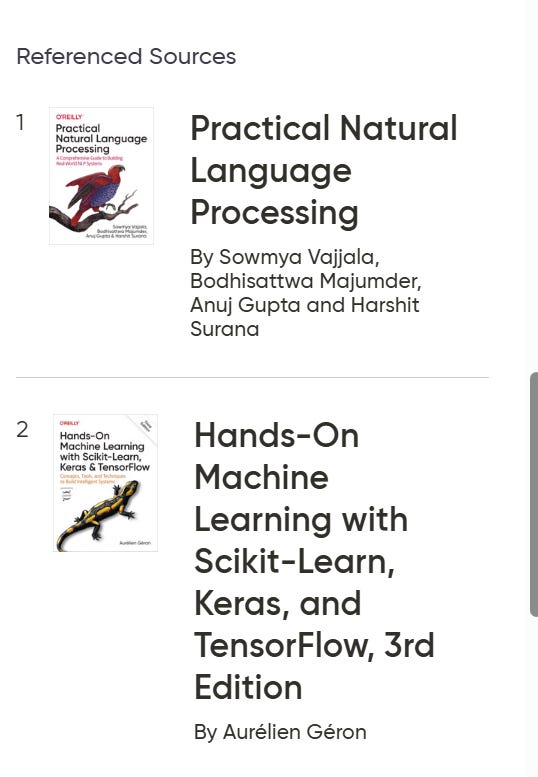O'Riley's AI Agent - AI Product Use Case
And how it keeps learners engaged
Hi there, it’s Matt! This is part of a larger series on AI product. Also check out our AI strategy thinking series.
Time to Read: 5 mins
It’s been an interesting last few week - and a lot of use cases reviewed. There’s a lot of question what a good GenAI product looks like.
These can be diverse. And great example I ran into recently was O’Riley Media’s AI agent. Yes, that O’Riley - the one with the animal covers.
O’Riley’s AI agent is interesting in one aspect: it combines questions with a recommendation system.
In today’s use case:
Give an overview of the O’Riley Chatbot - and why it’s an AI agent
Break down the product features and business value
Let’s check it out.
1. Why is the O’Riley Chatbot an AI product?
If you've been on various sites, you’ve probably started to notice more AI agents popping up. It’s not obvious ones either. LinkedIn, Amazon, and others have starting using it. But O’Riley’s is an interesting case.
Unlike retail like Amazon, O’Riley’s business model is different. Its main focus is educational content. This affects how the AI product works - there’s a huge difference.
Amazon's AI agent focuses on shoppers, providing product recommendations, managing orders, and enhancing the retail experience to drive sales. It reduces decision time and helps get data on customer needs.
O’Riley’s AI agent focuses on learners. It suggests learners questions, summarizes texts, and gives book recommendations. It keeps users engaged on the platform, making learning more interactive and efficient, and helping them find relevant educational content quickly.
Both are AI products - they’re focused on augmenting and enhancing user experience. No matter if an AI agent retail focused or learning focused, it's solving an important product need by improving user interactions and meeting specific demands.
Understanding augmentation and enhancement is key to successful AI products. I think at least 75% of the AI focused products I’ve built enhanced existing product offerings.
Let’s get into the problem and pain points.
What’s the pain points?
Getting learners on an education site can be hard. Keeping them is daunting - especially if most material is print. With a library of over 10k books and material? It can be hard to find what you need.
After completing one piece of content, learners may find it challenging to choose the next relevant material without appropriate guidance. Or even abandon a course.
Big pain points I’ve noticed for learning companies:
Content Overload and Discoverability - there’s too much to learn
Lack of personalized learning paths - it’s hard to start if you don’t know
Completion Rates for content - this is lower for books and long media!
Content Quality and Relevance - sifting through thousands of titles is painful.
No matter the online platform, keeping learners there can be difficult - especially with decreasing attention spans. Books or written materials especially in the age of TikTok.
That’s why recommendation systems, gamification, and even games come into play. You have to keep people on platform. Learning based companies is even harder - The content is more structured and requires focused attention.
Learnng overload is easy - and you can lose users and adoption.
So, having a deep content library of books or content isn’t enough. In depth learning requires sustained focus, that can be exhausting compared to the lighter, more varied engagement seen on social media.
In short: it’s difficult to do recommendations because the content is structured.
For a learning platform, that can be hard - they only have a limited window to keep the learner engaged and coming back.
So how does O’Riley’s AI agent try to reduce this?
2. User Experience First
We all read technical books and paper for our jobs. After you’re tired from reading it can be hard to sort out. Worse figure out what you need to research next. Cognitive fatigue can be hard on users.
One of the hardest lessons I learned from recsystems is cognitive fatigue can prevent users from keep learning. They might miss relevant recommendations. This applies to AI products too.
User experience must be prioritized to reduce cognitive fatigue. You can get greater user adoption of an AI agent if your business does that.
So how did O’Riley do that?
Question Prompts:
Users often aren’t always sure what to ask with AI agents. To encourage user adoption, it's good to display common questions they might be wondering about. We need to provide a starting point to mitigate cognitive fatigue.
In this case, we’re asking about NLP and transformers. We can click any of these to get started.
Best part is, the layout is clean and simple, with a clear call to action. This helps users focus on the task without being overwhelmed by too many options.
If the learner is certain, they can always ask a question in blank text box.
The prompts from these questions are the gateway. They provide recognized context for the AI agent. It takes that data answer a question, providing a summary, recommended books, and follow up questions.
Summarization
We don’t always want to read everything. When you have 10 books to reado on a topic like transformers? Getting to the main points is more important. Summarizing an short answer here is a great AI agent feature:
The point here is a learning framework. We want to encourage learning, by helping users quickly understand key insights.
The AI agent’s role in this part of the product is more than just providing info. Presenting concise summaries and main points boosts engagement and completion rates, as users are more likely to consume shorter, targeted information.
Referenced Sources
So you have a summary, but learners might want to research it. We want to address that. This were referenced sources work so well. I
In our example here we see three red numerical numbers in the summary:
If a learner clicks one, they are shown the source:
Each number references another book in the catalogue - getting learners to explore and create their own learning paths is big for online learning platforms.
Users gain quick insights, encouraging them to decide whether to dig deeper. It helps them create learner workflows. This encourages them to keep learning - demonstrating the value of the O’Riley catalogue.
Related Books
Sometimes even references are not enough for learners. But what to do?
If a learner is trying to understand transformers, we could suggest more books and O’Riley media - related to the book they’re reading.
The AI product feature here suggests books based off several factors:
book’s metadata
O'Reilly subject categories
similar user history
learner’s own history
It's essentially a very simple recommendation system.
This approach helps users discover high-quality, relevant content effortlessly, making the learning experience more personalized and effective.
Follow-Up Questions
Maybe a user is stumped. They’ve scrolled past the summary, related books, and recommendations. They’re getting frustrated - it's a good idea to implement interactive features like "Ask a Question" buttons at this point.
These can guide users to further explore relevant topics, keeping them engaged and helping them find more tailored information. O’Riley’s AI agent addresses these with follow up questions:
By providing concise and relevant questions, the design keeps interactions focused and efficient, encouraging users to read deeper into the topic.
This kind of interactive feature also turns a moment of pain into a chance for discovery. It helps users find gems they might not have stumbled upon just by browsing - adding depth to their learning experience.
Improving that experience is user experience - coupled with AI augmentation.
AI product design must mitigate cognitive fatigue through tech, user experience, and usability. This speeds up product adoption.
Each of these product features resolve the four big pain points I mentioned before. We live in an age where information overload is common. Great AI products use tech and UX to encourage product adoption.
If you want to check out a video of the chatbot in action, watch it here:
Takeaways
Key Features
O’Riley’s AI agent’s key features include:
Encouraging the Learner: Relieve a learner’s pain of reading through an entire text. The AI agent notes the context of the book. Then it suggests questions to provoke deeper thinking and engagement. This feature helps learners grasp complex ideas and tailor recommendations and follow up questions.
Recommendation: When users seek deeper knowledge, the AI agent recommends related books and media, prioritized by relevance. This keeps users engaged and encourages continued learning on the platform.
Learner in the Loop: The AI agent empowers learners by providing options like a question box, book recommendations, and follow-up questions. This feedback loop allows users to dive deeper into topics relevant to them.
Personalization: Learners forge their own learning path. The AI agent presents different options and questions, then tailors the experience to match that.
Business Benefits
Key benefits of AI agent include:
Real-time tracking of learning habits can significantly enhance user insights, leading to better content recommendations, improved user engagement, and ultimately more valuable data for building future AI products.
Optimized content offerings, leads to higher customer satisfaction and increased revenue. Attract a broader audience by providing personalized and effective learning experiences.
Expand customers access to the learning catalog - without tiring them out. Customers quickly find relevant material, stay engaged longer, and are more likely to explore and recommend the platform to others.
Final Thoughts
With all AI agents? Frame it as intelligent augmentation - not as AI.
I always notice a huge change in attitude in customers when I stopped framing it as “AI” and started framing it as an assistant. Customer’s assumptions about AI Agents can stop people from adopting or using an AI agent.
Frame your AI product so that it helps others do their jobs faster and better. In many cases, the correct framing is the difference between building a successful solution or dooming your project to fail before you even start.
Find ways to augment people, not replace them.
That’s it for today.
Before then, if you have any questions or comments, feel free to comment or reach out to me on:
Thanks for reading!
Enjoyed this article? Subscribe to get this newsletter every week 👇













I particularly like the last part of this issue. Frame the "AI" product without mentioning AI and instead talk about the benefit that the user can have by using it, i,e. "assisting." This is an excellent way to frame and escape the "AI" hype with non-sense expectations.